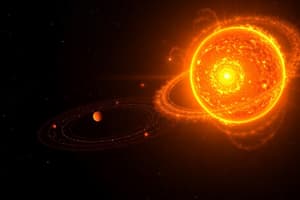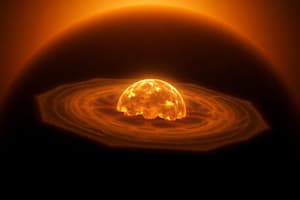Podcast
Questions and Answers
What is the Era of Nuclei characterized by?
What is the Era of Nuclei characterized by?
- Presence of large amounts of water
- Formation of rocky planets
- Existence of Hydrogen and Helium (correct)
- Extreme temperature and acidity
What are Jovian/Gas Giant Planets mainly composed of?
What are Jovian/Gas Giant Planets mainly composed of?
- Gases (correct)
- Molten lava
- Dust and rocks
- Water and ice
What does the Nebular Hypothesis state?
What does the Nebular Hypothesis state?
- The universe came from a tiny point called Singularity
- Matter is anything that occupies space and has mass
- Photon is the term used for the smallest particle of light
- A large cloud of gas contracted due to its self-gravity (correct)
What did George Lemaitre propose?
What did George Lemaitre propose?
What is a protoplanet?
What is a protoplanet?
What is the Nebular Hypothesis?
What is the Nebular Hypothesis?
What is the primary composition of Jovian/Gas Giant Planets?
What is the primary composition of Jovian/Gas Giant Planets?
What is the Era of Nuclei characterized by?
What is the Era of Nuclei characterized by?
What did George Lemaitre propose?
What did George Lemaitre propose?
What is the term used for the smallest particle of light?
What is the term used for the smallest particle of light?
Flashcards are hidden until you start studying
Study Notes
Era of Nuclei
- Characterized by the formation of atomic nuclei, primarily hydrogen and helium, in the early universe.
- Occurred shortly after the Big Bang when temperatures and densities decreased enough for protons and neutrons to combine.
Jovian/Gas Giant Planets
- Mainly composed of hydrogen and helium, with traces of heavier elements.
- Large atmospheres surround small rocky cores, leading to significant differentiation in structure and composition.
Nebular Hypothesis
- Proposes that the solar system formed from a rotating disk of gas and dust known as the solar nebula.
- The process involves the gravitational collapse of this nebula, leading to the formation of the Sun and planets.
George Lemaitre's Proposal
- Proposed the idea of an expanding universe, leading to the formulation of what is now known as the Big Bang theory.
- Suggested that the universe originated from a "primeval atom," which underwent rapid expansion.
Protoplanet
- A large body formed through the accumulation of dust and gas in a protoplanetary disk.
- Represents a stage in the development of a planet, before it becomes fully formed.
Primary Composition of Jovian/Gas Giant Planets
- Dominantly hydrogen and helium, which contributes to their low density compared to terrestrial planets.
- Envelopes of gases extend to large diameters, characterized by a lack of solid surface.
Smallest Particle of Light
- Referred to as a "photon."
- Represents a fundamental particle in quantum mechanics, crucial in the study of light and electromagnetic radiation.
Studying That Suits You
Use AI to generate personalized quizzes and flashcards to suit your learning preferences.





